| home | |
| diy audio | |
| family | |
| links | |
| music | |
| email me | |
©2003-2005 Jeremy Epstein. No reproduction, retransmission or web distribution without prior permission.
UPDATE!
A Push-Pull Audio amplifier design using the "Iron Concertina" phase splitter
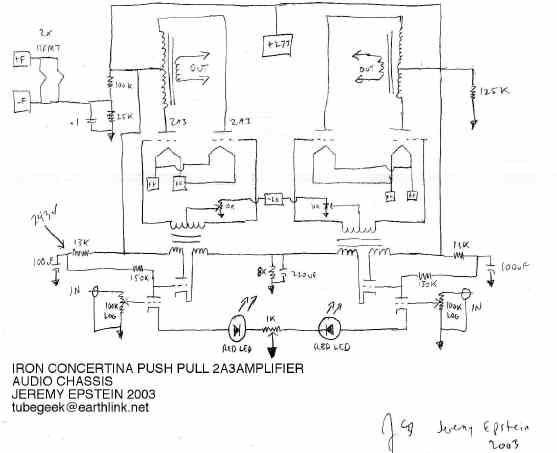
Click For a Larger Audio Circuit Design Image
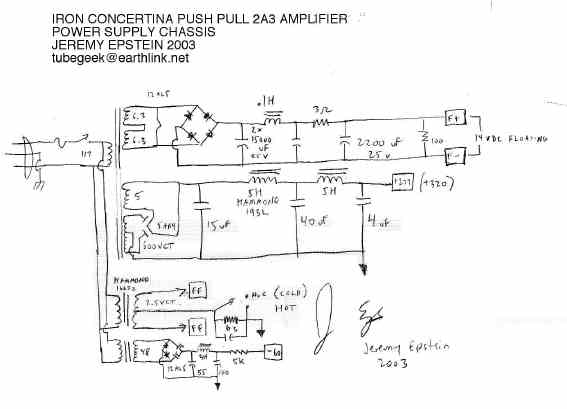
Click For a Larger Power Supply Circuit Design Image
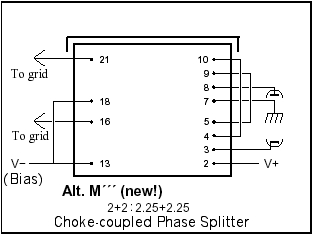
Connection Diagram for Lundahl 1660 interstage transformer
(Below is the original "Iron Concertina" article)
One day, I was perusing the Radiotron Designer's Handbook (4th ed.) and an interesting phase splitter circuit caught my eye. It is described on page 355, and shown in Figure 7.51D.
Thanks to Bill Perkins, manufacturer of the PEARL Tube Coolers and diligent archivist, I obtained the original article, "A Choke-Coupled Phase Invertor Of High Accuracy," by Seymour and Tucker upon which the chapter in the RDH4 is based. Below is their diagram of the circuit, which is identical to the diagram I saw in the RDH4.
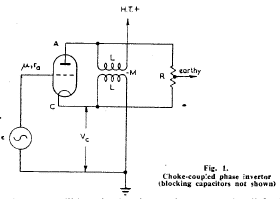
As I read the description of the circuit, it became clear that a "coupled choke" is what one might normally think of as a 1:1 interstage transformer. I had seen a tube output stage discussed that use a similar coupling between cathode and plate circuits to give a negative feedback effect, and this circuit was described as having negative feedback as well, which was claimed to afford excellent bandwidth and low output impedance, all of which sounded just ducky to me.
There was another wrinkle I envisioned as I thought about this circuit. If a 1:1:1:1, four-winding interstage transformer could be used, then the phase splitter could be coupled to the following stage's grids without coupling caps, and this stage could be given a fixed bias via the windings used as the two "secondary" coils. (In fact, each stage could have its own adjustable fixed bias: there's no reason the two coils need to be connected at the ends that are not connected to the grids. In other words, the two secondary coils could each have their own adjustable "C-" voltage in the diagram shown below.) To my way of thinking, this circuit has a number of good features: first, it is as balanced as a phase splitter can possibly be. The only limitation is the symmetry of the two "secondary" windings. Second, the feedback operation of the coupled plate and cathode makes it very low in distortion and very low in output impedance. Finally, using the 4-winding version, a push-pull amp with no coupling capacitors can be built.
Here's a diagram of the modified circuit, including the output stage, which I call the "Iron Concertina," after its similarity to the resistively-loaded "concertina" phase splitter topology:
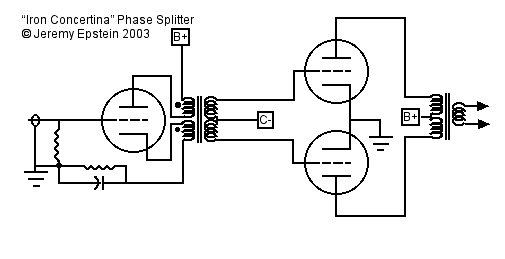
Once I had drawn this circuit, I was determined to try it in my next amplifier, which I had already decided was going to be a push-pull 2A3 amp. I decided to try a different approach with this amp's driver stage than I had with my "Free Lunch" single-ended 2A3 amp. With the "Free Lunch," I had gotten both voltage gain and a low output impedance driver with one tube: the 6C45Pi triode. But the 6C45Pi has one drawback: the bias voltage is just a little too close to the expected input signal magnitude for comfort. In practice, this hasn't been a problem in my system, but I thought it would be interesting to try and avoid this design "flaw" in my next from-scratch design. I thought I would try using 6SL7 (high mu, low current, high rp) as a voltage amplifier and use this to feed a 12B4A (low mu, high current, low rp) which would drive the "Iron Concertina" section. I even bought some 12B4A's for this purpose.
At this point I went off on a tangent. I had bought some inexpensive Allied interstage transformers and I started trying to make them suitable for the 4-winding interstage I needed. These transformers are wound with three physical coils: one pair have half ther number of turns of the the remaining coil, and these two are joined internally to make a center tapped winding. So they have a 1:2:1 turns ratio, in order from the inside of the coil stack to the outside. I started taking them apart, in order to find out whether the "2" coil was made up of one winding or two. I found out two things, both to my frustration: one, that the middle coil was a single untapped winding, and two, that the internal wire was very thin and broke easily under my experiments. I managed to repair the transformer and I thought of a great idea for modifying it: I could remove all the "I" laminations from the transformer stacks of two of these transformers. Then I could butt them together, "E" to "E" with the open ends of each "E" facing each other. In this way I could construct an air-gapped transformer that would not saturate with the large DC current demanded by the 12B4A and I could modify the internal connections to get the four seperate, equal windings I needed. These would be assembled from the six seperate coils I now had available: 1:2:1 on the first core and 1:2:1 on the second. I figured I'd combine one of the "1" windings from each of the coil stacks to make composite "2" coils, in order to ensure good coupling between both cores and good symmetry.
I got so far as to take apart the lamination stacks and add the necessary internal connections needed to sperate the center-tapped coils, but then I changed my mind. I was able to get a great price on some Lundahl LL1668 plate chokes and I swapped those into the "Free Lunch" amp in place of the original Lundahl LL1660 interstage transformers. The LL1660 is a "Swiss Army Knife" of a transformer, with many windings, all of which are brought out to external connections. It seemed much simpler and more likely to work well, to use this excellent quality transformer instead of my Frankenstein'ed Allied interstages.
Well, I did SAY it was a tangent!
Meanwhile, looking in the GE Essential Characteristics manual, I had come across an interesting family of dissimilar dual triodes which were intended for service in tubed television sets. Intended to drive the vertical pulse circuit, they each contained a high-mu triode (the vertical oscillator) and a low-rp, high current power triode (the transformer driver). (I guess this was what was connected to the "Vert" adjustment pot on the back of the old TV's.) Some examples of these are 6DE7, 6DN7, 6EA7, 6EM7, 6EW7, 6FD7, 6FJ7, and 6FM7. Their original purpose - putting a large-magnitude, low-frequency pulse through a transformer - is actually very similar to what we are asking of them in an audio power amplifier. (The original Bottlehead "S.E.X." kit used 6DN7's, by the way.) What caught my eye in looking at these tubes' short-form characteristics were the extremely low rp values: even less than the 12B4A's 1030 ohms, some were as low as 800 ohms. All the better to really drive the phase splitting transformer.
A little further along in the book, I found that there were 13V-heater counterparts to these 6.3V-heater tubes. It's been my experience that many tubes that don't use the standard 6.3V or 12.6V heaters are dirt cheap. And a 12.6V filament transformer, if it is not supplying its full rated current, will actually supply over 13V under light load. Or you can rectify the 12.6VAC and get something like 15 or 16 VDC after the ripple filter. I quickly zeroed in on the 13FM7 dual triode and found some (dirt cheap!) plus some 12-pin compactron sockets (which were NOT as cheap.)
The 13FM7 is a good tube for audio. I have also used them in another circuit - they make a great two-stage, one-tube-per-channel, flea-powered amp, maybe 2W per channel. They can be direct coupled between their two stages (so, still NO coupling caps!) using a reasonable B+ voltage and they sound very good subjectively. They are perfectly suited to the "Iron Concertina" circuit.
The push-pull 2A3 amp I built using this phase splitter sounds very open and has very extended bandwidth at both top and bottom. The extra power and bass control is definitely there in the push-pull amp as you'd expect, and the inherently low 2nd harmonic distortion of the push-pull arrangement makes for a sound that doesn't mud up loud rock music. This phase splitter also retains the purity of my "Free Lunch" amp, as well, which is one of the hallmarks of a single-ended amplifier's sound. There is no hint of listening fatigue - quite the opposite, it's "play all day" and then some. Where I find the push-pull amp lacking slightly is in the imaging magic that single-ended amps seem to excel at. The push-pull 2A3 isn't quite as much of a time machine as many single-ended amps are, with their uncanny ability to draw you into another time and place. But it does rock!
-j